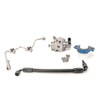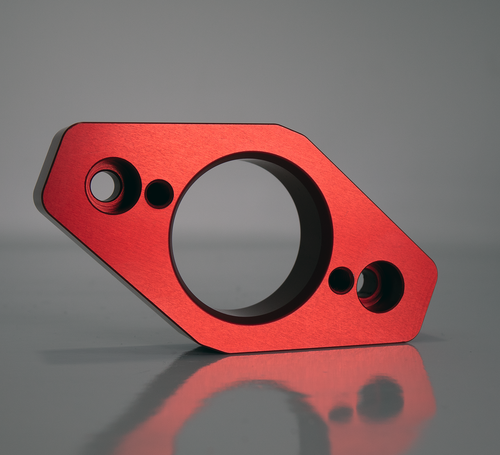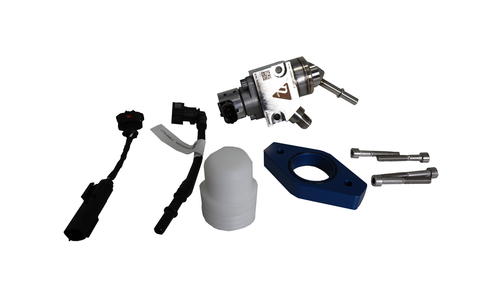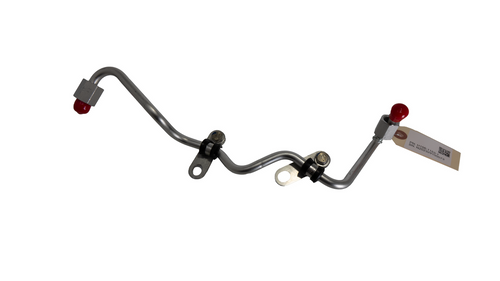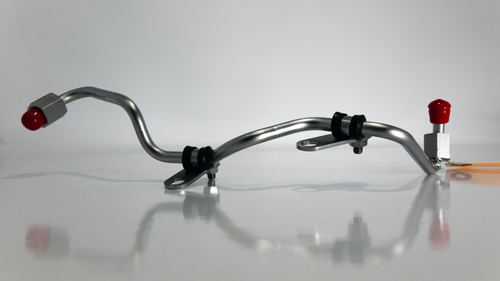We have a lot of development/refurbished parts on the shelves and need to make room! Being that most of these parts were used as development or sponsorship parts and were likely previously installed, you have the opportunity to save big money over purchasing a new kit.
Each of these parts have been cleaned and put back through the same rigorous and thorough testing process that all of our production parts go through, and have passed with flying colors. All of our refurbished parts are backed by the same great limited lifetime warranty as everything else that we sell.
Supplies are limited, once the refurb parts are gone, that’s it! Don’t miss out on that fuel system upgrade you have been looking for!
***SAVE 20% on 2.3 EB injectors when purchasing a refurb kit!***
What sets the Nostrum 2.3L Big Bore pump kit apart:
- Fully Laser Welded HPFP Construction
- Custom High Pressure Fuel Line
- Direct Bolt on Kit
- Uses Stock Low-Pressure Feed Line
Achieve v8 levels of power! Ecoboost Mustang is an impressive car out of the box, but there are those of us that are always looking for more power. While the 2.3 Ecoboost does respond very well to modification, they quickly become limited by the factory fuel system.
Nostrum’s HPFP for the Ecoboost 2.3 is capable of flowing 63% more fuel than the factory fuel pump. The additional fuel flow allows you to dial in more boost earlier, resulting in a substantial increase in low end torque. Being that our pumps are ethanol compatible, you also have the added benefit of being able to run e85 or blended ethanol fuel. Ethanol is wonderful on turbo cars, as it has a higher octane rating and is less prone to knock than 91/93 pump gas, and you have the potential to make more power as a result. Our pumps are tunable on Cobb and ECUTek software.
Nostrum backs every part we sell with a limited lifetime warranty. All Nostrum products come complete with everything you need inside the box, including detailed installation instructions. Tuning guides are also available for your dealer or tuner. We have customer service and calibration engineers on staff to provide you with any support that you may need, from installation to tuning.
What comes in box:
- High Pressure Fuel Pump - fully welded, stainless steel construction (63% flow increase over stock pump for the application)
- E85 compatible
- Pump kit includes accessories needed for installation including high pressure tube, mounting flange
- 100% production tested
- Install Guide provided
- 2015-2023 Ecoboost Mustang
Recommended tuners:
- JEM Sport
- Panda Motorsports
- ZFG Racing
- Parker Performance
- Lethal Performance
- Stratified Automotive Controls
- Livernois Motorsports
- PD Tuning
Dyno graph sponsorship results:

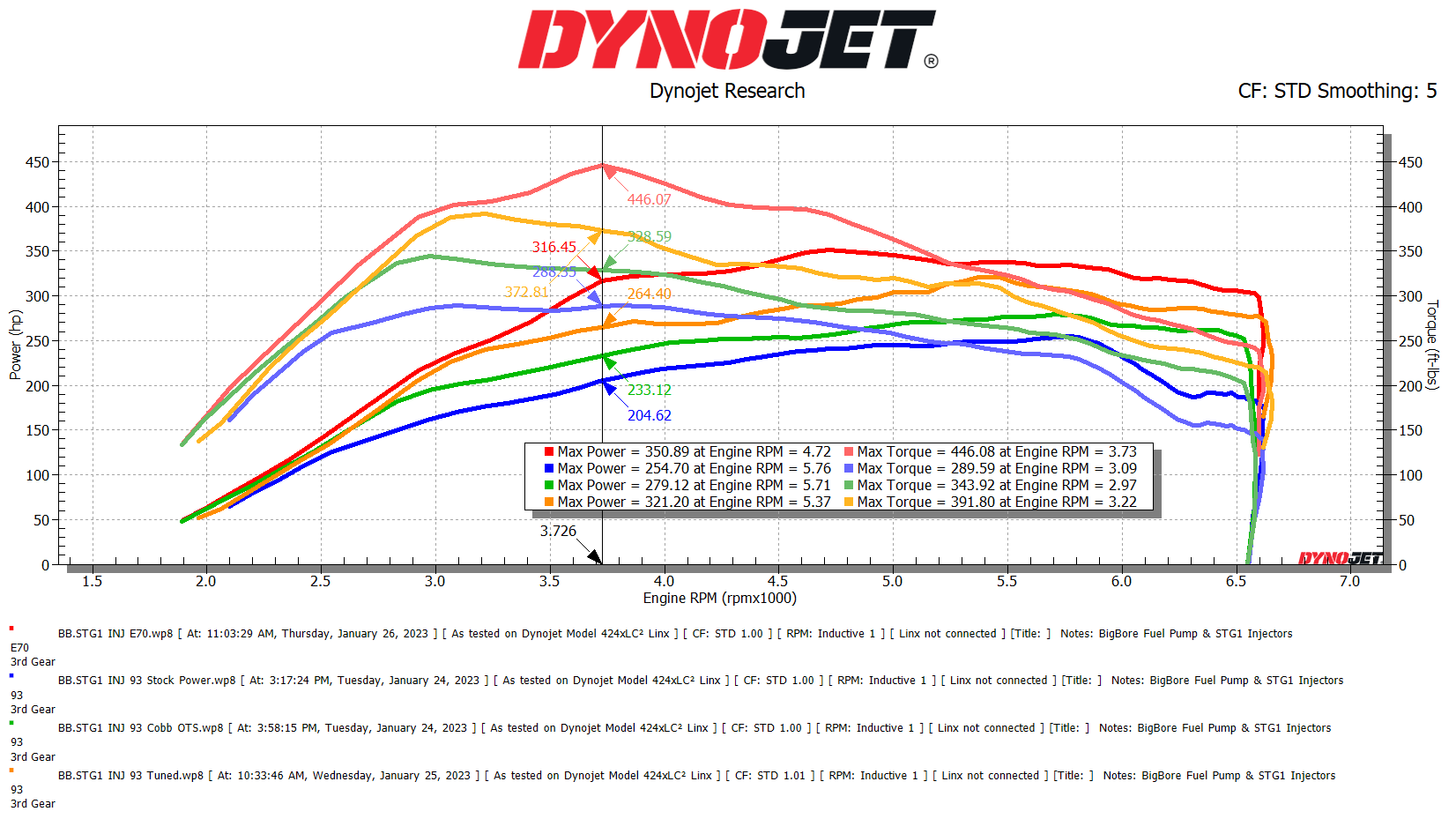
We saw some impressive gains on a completely stock Ecoboost Mustang. It put down more torque on Pump E85 than a stock Coyote - Not bad for a car with a stock intake, downpipe and turbo!
*Horsepower and Torque numbers are approximate and can vary significantly depending on numerous factors including what supporting upgrades are done to the vehicle, ambient temperature, elevation, road surface, tire selection & condition, fuel octane and quality, vehicle weight, and more. The advertised numbers herein are based on optimal conditions and utilizing proper supporting modifications. Your results may vary.
Frequently ask question:
Q: Why don't I see horsepower gains with just a pump?
A: Fundamentally we have to look at the entire fueling system and "where" in the rpm range the limits are. DI fuel systems in stock trim are often pump limited at middle rpm (peak torque) and injector limited at high rpm (peak power). This is due to engine speed. HPFPs are mechanically driven pumps (driven by the camshaft pump lobe spinning at ½ crank speed) and are RPM (engine speed) dependent. Many of the quoted flow increases in the aftermarket are purely displacement based comparisons: where by example the big bore pump has a piston diameter X% larger than the "stock" pump or the swept displacement ((3.14*(radius)^2)*(stroke))of the pump Y% larger than the stock pump. The larger displacement of the pump really shines in low rpm, where the fuel injector has plenty of time (crank angle degrees) to inject fuel. As the engines starts to approach peak power the engine speed starts to become quite short and is limiting the injection duration (crank angle degrees) for the injection event (which is another reason why we like to increase fuel pressure up high!).
Q: Why can't I run straight ethanol with your pump? (FAQ Posted 6/9/23)
A: This is incorrect! We highly recommend running E85 from the pump on our products! Intermediate ethanol blends, like E30 to E50, are problematic (with any fuel system, stock and aftermarket). What happens is that Ethanol is a polar liquid, and all petroleum distillates are nonpolar; this means most things that can dissolve in Gasoline, are not soluble on Alcohol, and vice versa. Fuel manufacturers know this and choose their additive packages accordingly. Problems arise when you take E85 and then blend it down to ~E30 - E50. At these concentrations some of the gasoline additives will come out of solution, and they form a slimy, sticky residue that clogs everything up. It seems to be regional and seasonal in nature, which makes sense when you consider that E85 blends vary with the seasons. Running straight gasoline through the fuel system seems to fix it. If you choose to run intermediate blends then we do recommend that you run straight 93 gasoline from time to time to as a fuel system maintenance practice. That being said, we absolutely highly recommend pulling up to the pump and going full Pump E85 (P-E85)!!!!
Q: Why do your numbers say I will make less horsepower on E85 than 93 octane?
A: Great question! The numbers we list in the product descriptions are similar to the numbers a turbo charger lists for air flow. The numbers are the "fuel system capacity to generate power" regardless of the other engine system limitations (air handling, mechanical limitations, knock propensity). Essentially the numbers are calculated assuming "sufficiently large air flow", "sufficiently capable mechanical assemblies" and disregarding knock limits. The equation uses actual observed engine volumetric efficiency (when available from sponsorship vehicles) and fuel capacity (including target pressures) to calculate power. Gasoline has more energy per mass volume than E85. So the higher fuel flow capacity will mathematically generate higher power potential for a gasoline than a high ethanol content fuel. The other variables (air flow, spark, rotating assembly strength, charge cooling, mechanical assembly strength) are highly variable from build to build. This is why we state horsepower capacity for the fuel system – representing the potential of the fuel system if you have all the other aspects of your build addressed!


